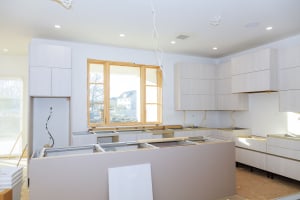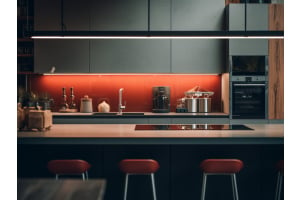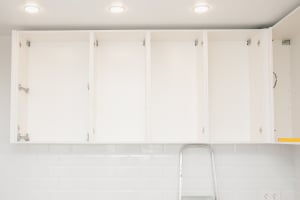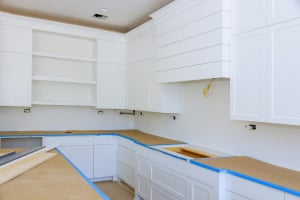Many American homes built in the last thirty years have a walk-in pantry or a small reach-in pantry with a full door similar to a small hallway closet. Older homes, as well as condos, typically do not feature pantries. These homes instead rely on cabinets for food storage.
In all but the largest kitchens, storage space is at a premium. This is why many cabinets take advantage of depth, rather than width, to make room for household goods. Tall kitchen cabinets that are narrow but deep can be an excellent choice for use as a pantry, but how deep is too deep?
Industry Standards in Cabinet Depth
Before we dive into cabinet depth, we need to understand the different parts of kitchen cabinets. Typically, kitchen counters have cabinets and drawers beneath them. These are known as base cabinets. The cabinets above the counter and attached to the wall are known as ‘wall cabinets’ or ‘upper cabinets.’
When selecting pantry cabinet dimensions, it’s essential to strike a balance between available space and functionality. Standard pantry cabinets typically range from twelve to thirty-dix inches in width, with depths matching base cabinets at twenty-four inches or more.
Heights can vary significantly, with tall pantry cabinets often reaching up to eighty-four inches, providing ample storage from floor to ceiling. For smaller kitchens, narrow pantry cabinets with a depth of twelve to eighteen inches can maximize storage without overcrowding the space. Customizing your pantry cabinet dimensions ensures it complements your kitchen layout while offering optimal storage solutions for everyday and long-term use.
Base cabinets are typically quite deep at around twenty-four inches. However, they vary in size and are sometimes found in twelve-inch, eighteen-inch, and thirty-six-inch variants. Upper cabinets are almost always shallowe, at twelve, eighteen, or twenty-four inches. This allows a person to work at the kitchen counter without bumping their head on the upper cabinetry.
Depth is an important consideration in any kitchen and varies greatly according to the available space. Narrow kitchens, like those found in condominiums, typically have eighteen-inch-deep base cabinets, with upper cabinets being twelve-inches deep.
Larger kitchens, such as those featuring an island, may have base cabinetry at the full twenty-four or thirty-six-inch depth. While this sounds fantastic from a storage perspective, a thirty-six-inch-deep cabinet can make locating things difficult.
Upper cabinets simply cannot be this deep, unless the homeowner is going to use a ladder every time they need something from the back. Ultra-deep cabinets are a choice that must be carefully considered.
What Are Pantry Cabinets?
The difference between a pantry and a cupboard or cabinet is typically height. This is why some people refer to cupboards as tall cabinets. Pantry cabinets may feature double doors that swing out in opposite directions, or they may be a single-door, narrow cabinet that has shelving from top to bottom.
They also come in multi-door styles featuring separate upper and lower cabinets. This allows for quick access, as many people fill the lower cabinet with everyday needs and upper, smaller cabinets with long-term storage items like pasta, beans, and other non-perishables.
As for depth, pantry cabinets come in the same full range of sizes as regular cabinetry. The most important consideration for the depth of your pantry cabinets is the depth of the surrounding cabinetry. Try to place your pantry cabinet between the end of a counter and the wall, or next to one end of the counter if you have an open kitchen.
Ideally, you want your pantry cabinet to have the same depth as your base cabinetry. This ensures a symmetrical look. Even if the upper cabinetry is shallow, it won’t matter, because your pantry cabinet will function as a wall where your kitchen counters and base cabinetry end.
Upgrade Away
At 27estore, we have a large selection of pantry cabinets of various widths, depths, and wood materials to match any existing cabinetry that you have. Browse our full selection today and see how 27estore can help transform your kitchen into a stylish and efficient space!













